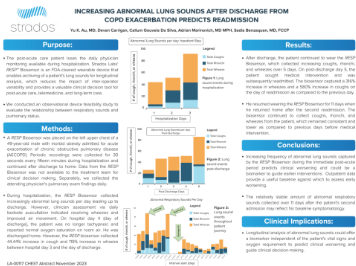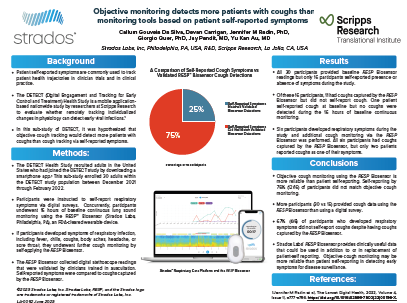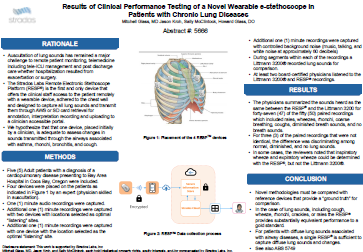For COPD
Improve disease surveillance in at-risk COPD patients
Chronic Obstructive Pulmonary Disease (COPD) places a significant burden on healthcare systems, with readmission rates often exceeding 20% within 30 days.1
Traditional methods of assessing respiratory status in COPD patients remotely have limitations, with patient self-reporting less consistent than objective methods and auscultation with a stethoscope limited to episodic, in-person visits. FEV1, while valuable in measuring disease progression is not used to prevent exacerbations and lacks insight into patient quality of life.2
New innovations have been developed to offer clinicians and patients greater control over exacerbations and insight into respiratory status remotely, with objective monitoring of cough and lung sounds emerging as a promising approach.3 Increased cough and wheezing are common early warning signs of deterioration for patients, with studies showing that increased coughing can predict exacerbations up to 3.4 days in advance.4
Improve COPD Disease Surveillance with RESP®
- Clinically validated accuracy, with equivalent performance to Littman 3200 stethoscope.
- Continuous monitoring of cough and lung sounds to offer quantitative data on respiratory symptoms over time.
- Patient-friendly, reduces the burden on patients while improving clinician efficiency.
Certifications: FDA 510(k) clearance, CE Mark, HIPAA Compliant
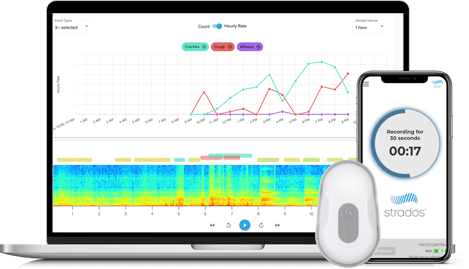
COPD Patient Case Study¹
- The RESP Biosensor was used to independently track lung sounds of a 49-year-old male admitted for acute exacerbations of COPD.
- After 4 days, the patient was discharged based on traditional functional lung indicators. However, the RESP Biosensor showed a 44% increase in cough and a 119% increase in wheeze between day 3 and 4 prior to discharge.
- The patient was ultimately readmitted 5 days after discharge; the RESP Biosensor could be used to predict clinical worsening, guide early intervention, and avoid readmission.
1. K. Au, et al. Increasing Abnormal Lung Sounds for COPD Exacerbation Predicts Readmission. CHEST Conference 2023. View Abstract
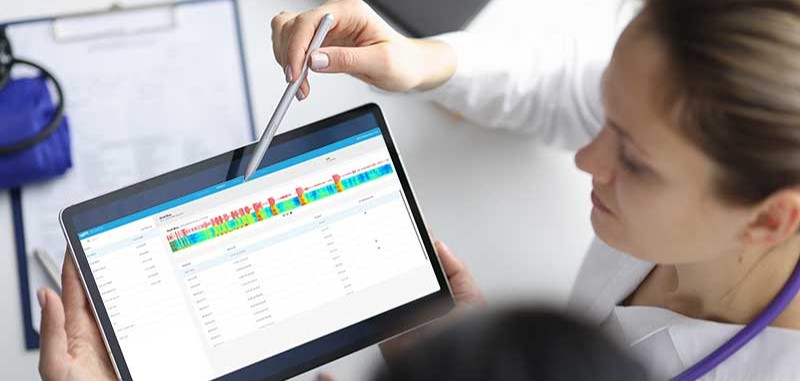
For Healthcare
Manage COPD from hospital to home with real-time monitoring of symptoms

For Life Sciences
Gain greater, objective insight into subject treatment response in COPD clinical trials
Interested in a Research Collaboration?
We’re seeking clinical and academic collaborators to explore how wearable respiratory technologies can improve patient outcomes. Partners may be eligible for in-kind support.
Track Patient Progress Objectively and Remotely
Patient reports include accurate, time-stamped data on signs and symptoms such as coughing and wheezing, allowing for greater diagnostics and insight into treatment response.
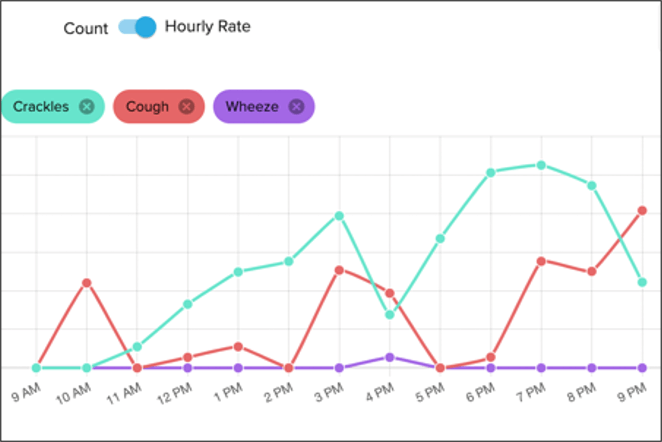
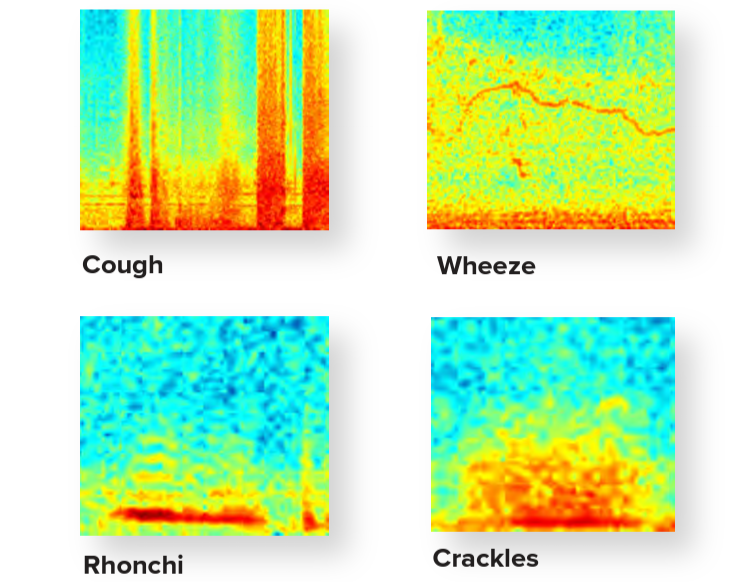
Publications
How is data collected by the RESP® Biosensor transferred to the cloud?
Lung sound recordings captured by the RESP® Biosensor are transferred via Bluetooth to a companion patient mobile app, and from there is sent to the Strados cloud via Wi-Fi or cellular data.
How exactly are the lung sound events (i.e. cough, wheeze) detected and annotated?
We have developed a validated overread process that includes our team of respiratory therapists and specialists who manually review lung sound recordings to meet regulatory and clinical requirements for data accuracy.
Our machine learning algorithms have also been trained based on clinically validated labeled data and performance tested to meet customer requirements. Algorithms can be used independently for event detection or to feed data to our validated overread process.
How long do COPD patients typically wear the RESP® Biosensor?
The RESP® Biosensor is often worn for 24-hour periods in clinical trials and has roughly a 25-hour battery life. However, patients can wear the device anywhere from 7 days to 30 days. Patients are given two devices and if they’re instructed to wear the device on consecutive days; they will need to replace the device with a fully charged one after the battery runs out every 24 hours.
Let’s Talk
Explore using the RESP® Biosensor in your study or practice
References
- Li, M., Cheng, K., Ku, K., Li, J., Hu, H., & Ung, C. O. L. (2023). Modelling 30-day hospital readmission after discharge for COPD patients based on electronic health records. NPJ primary care respiratory medicine, 33(1), 16. https://doi.org/10.1038/s41533-023-00339-6
- van der Molen, T., Miravitlles, M., & Kocks, J. W. (2013). COPD management: role of symptom assessment in routine clinical practice. International journal of chronic obstructive pulmonary disease, 8, 461–471. https://doi.org/10.2147/COPD.S49392
- Wang, J. M., Han, M. K., & Labaki, W. W. (2022). Chronic obstructive pulmonary disease risk assessment tools: is one better than the others?. Current opinion in pulmonary medicine, 28(2), 99–108. https://doi.org/10.1097/MCP.0000000000000833
- Crooks, M. G., den Brinker, A. C., Thackray-Nocera, S., van Dinther, R., Wright, C. E., & Morice, A. H. (2021). Domiciliary Cough Monitoring for the Prediction of COPD Exacerbations. Lung, 199(2), 131–137. https://doi.org/10.1007/s00408-021-00435-9
